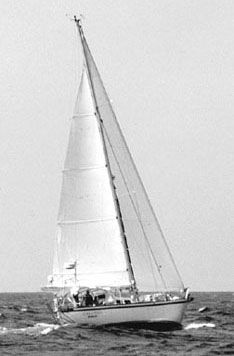From start to finish, we had spent almost exactly four weeks covering the 1300 miles from Bab el Mandeb to Port Said. Four weeks were long enough for us. For some boats, the Red Sea is a cruising destination. For others, like ourselves, the Red Sea is a potentially troublesome stretch of water to be transited as quicklyas possible without beating up either the boat or the crew.

For the northern two-thirds of the Red Sea, the prevailing winds in spring are strong northwesterlies—right on the nose—and the seas are short and steep. We had enough of a taste of those wind and sea conditions to know that we could makelittle headway against them. Instead, we waited for forecasts of lighter winds, and motored or motorsailed when necessary to keep the speed up. Calms could literally turn into 35-knot headwinds in a matter of minutes, so there was no relaxing. On the rare occasions when the winds werefavorable, they were generally so light that the motorwas required to keep the boat moving at a rationalspeed. Fortunately, we had several suitable weather windowsthat allowed us to make good time.
The usual strategy is to bite off small chunks of the Red Sea when conditions allow, slowly working your way northwards. Instead, we put the pedal to the metal when conditions allowed, making longer jumps. We stopped only four times, after our short, unintended stop on a coral reef in the southern Red Sea.
Our first port was Massawa, Eritrea, a towndevastated by war and heartbreakingly poor. Our secondanchorage was a stunningly beautiful deserted inlet inthe Sudanese desert, just south of the Egyptianborder, where we waited out three days of strongheadwinds. Our only companions here were wild camelsgrazing on virtually invisible amounts of vegetation.
We then jumped to Safaga, Egypt, just south of theGulf of Suez, where we sat out two howling sandstormsin four days. A two-day calm enabled us to motor fromSafaga the rest of the way to Port Suez, the gatewayto the Suez Canal.
A passage of the Suez Canal is far less dramatic thana transit of the Panama Canal, since the Suez isnothing more than a dredged ditch at sea level, withno locks. The downside is the constant badgering bysome pilots for gifts—baksheesh—which they seem tothink is their birthright. Our pilot for the first daywas young and professional, and asked for nothing. Ourpilot on the second day was one of the most notoriousbeggars in a country known for beggary. He asked forcigarettes, chocolates, beer, perfume, my hat, mysunglasses, my shirt, my jacket—anything that wasn’tbolted down. We gave him dollars and cigarettes—thestandard “gift”—but he wasn’t happy. We were glad to get rid of him, and were even happier to be in the Mediterranean at last.
Eighteen hours after exiting the Suez Canal, weentered the marina in Ashkelon, Israel. The almostnightly Israeli air raids on Gaza—just a few miles tothe south—made things a little tense for us. Israel lives in a perpetual state of near-war with allits neighbors, and you get used to the dockboys in themarina wearing sidearms, and the M-16s on the table atthe local McDonalds. Some cruisers, however, were souncomfortable with all the weapons that they leftalmost immediately for Cyprus. Never mind that Greekand Turkish Cyprus have been in conflict almost aslong as Israel and her neighbors!
We endured two sandstorms and one dust storm in theRed Sea. We also found ourselves in the middle of an oil spill in Port Suez—a ship had pumped its bilges before transiting; the oil soon coated our waterline, which was then covered by dust. What a mess it made! By the time we reached Israel, all of our standing rigging and running rigging werecoated auniform brown. The entire boat was caked with dust andsand, and the low humidity had left all the runningrigging in solid, rigid masses that were impossible tocoil down. We felt frozen in hot, brown ice.
In Ashkelon, we spent four solid days cleaning theoutside of the boat. I took a hose to the masthead,and brown mud poured off the mast and rigging. Weremoved all the sails and washed them, pulled everyhalyard, soaked every sheet, flooded the deck hardwarewith fresh water. We used tons and tons of freshwater, and still the scuppers ran brown. Years fromnow, a future owner of Calypso will dig sand out ofsome corner and wonder where it came from. It will bea small bit of Egypt, still haunting the boat.
In the eleven months since we left New Zealand,Calypso has covered some 11,500 miles. Over 21,000miles have passed under the keel in the past three anda half years. The GPS says that our home port ofNewport, Rhode Island lies only 4800 miles northwestof us.
Across the vast expanses of the Pacific, through thesweltering heat of Southeast Asia, even through thedry, desolate beauty of the Middle East, Calypso’svoyage seemed endless, at times even impossible. Nowthat we are in the Mediterranean, things seemfamiliar, almost homelike. Can it be that less than ayear from now, God willing, we will cross our outboundtrack in some island in the West Indies?
There are times when we wish the voyage to befinished. There are other times—much more often—whenwe wish the journey would go on forever. Life iscruising; cruising is life.
Also With This Article
Click here to view “Maintaining Hardware.”
Click here to view “Faulty Fram Filters.”




































